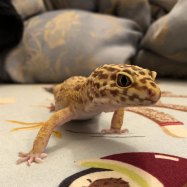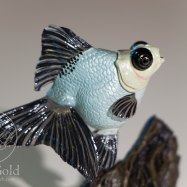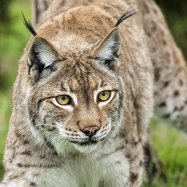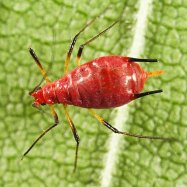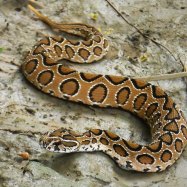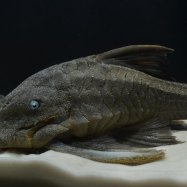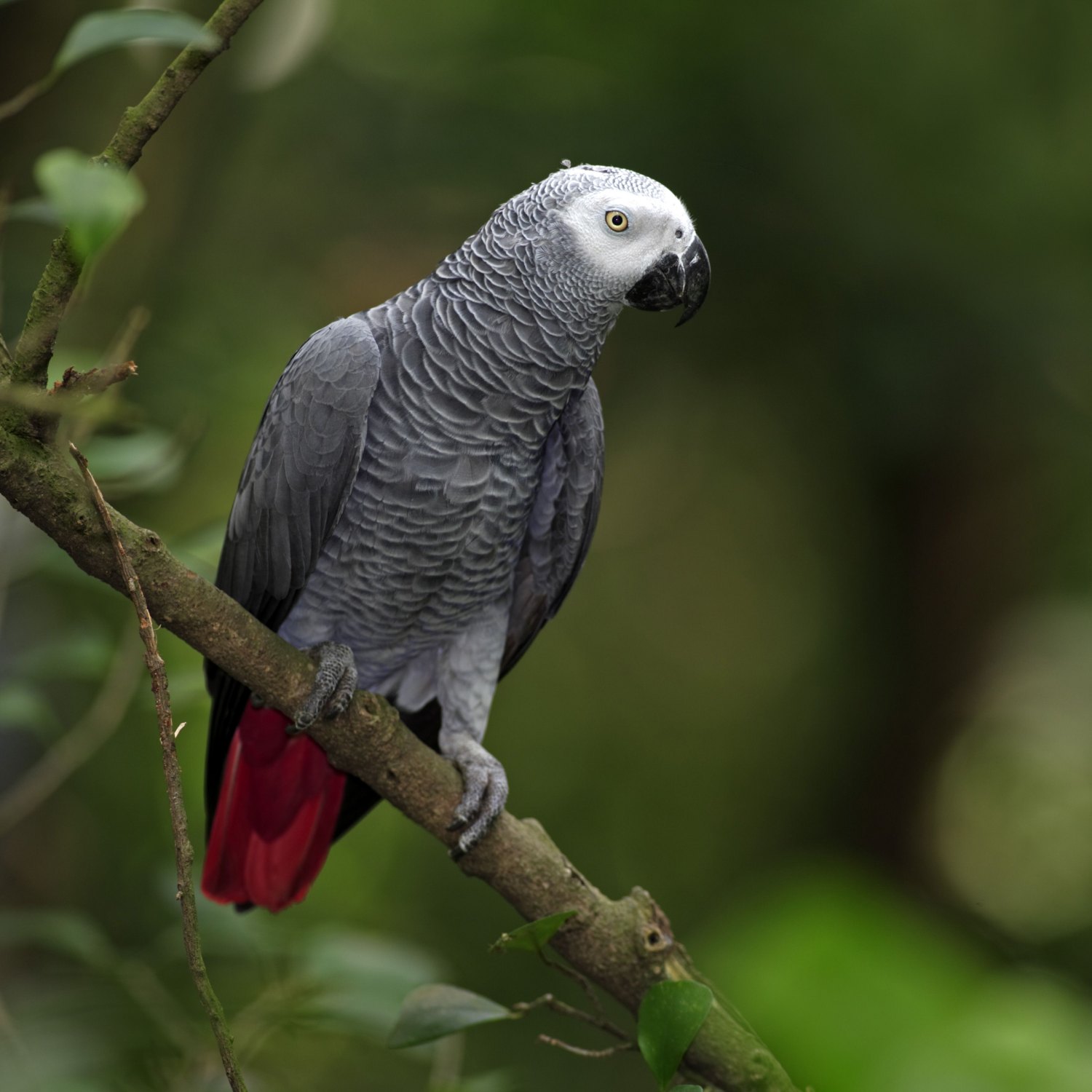
African Grey Parrot
30 - 40 cm
The African Grey Parrot is a fascinating bird native to Africa. With a length of 30-40 cm, they belong to the medium-sized category of birds. The Psittacidae family is known for their bright colors and incredible intelligence. Their stocky build makes them efficient flyers and their unique ability to mimic human speech makes them popular pets. You can find these intelligent birds in the wild, or as companions in homes around the world.
Animal Details Summary:
Common Name: African Grey Parrot
Kingdom: Animalia
Habitat: Rainforests, woodlands, and coastal mangroves
The Fascinating African Grey Parrot: A Unique Species of West and Central Africa
If you are a bird lover and fascinated by the vibrant and diverse avian world, then the African Grey Parrot is a bird that you must have surely heard of. Also known as the Grey Parrot or the Congo African Grey Parrot, this species is a highly intelligent and captivating bird, known for its exceptional ability to mimic human speech and its striking grey coloration.But there is more to this magnificent bird than just its ability to mimic and its grey feathers. In this article, we will delve into the fascinating world of African Grey Parrots, exploring their unique features, habitat, behavior, and more African Grey Parrot.
The Classification of African Grey Parrots
The African Grey Parrot (scientifically known as Psittacus erithacus) belongs to the Kingdom Animalia, Phylum Chordata, and Class Aves. It belongs to the order Psittaciformes, which also includes other parrot species and cockatoos. Within this order, African Grey Parrots belong to the family Psittacidae, which is the largest family of parrots and includes over 300 species.This species of parrot is native to the tropical rainforests of West and Central Africa, making it a significant part of the avian biodiversity of the African continent. It is mainly found in countries such as Cameroon, Côte d'Ivoire, Ghana, Guinea, and Liberia.
The Habitat of African Grey Parrots
African Grey Parrots are known to inhabit a variety of habitats, including rainforests, woodlands, and coastal mangroves. They are mostly found in dense, tall trees that provide them with shelter and food. They are also known to live near rivers and streams, as they rely heavily on these water sources for survival.The African Grey Parrots are highly adaptable to their surroundings and can thrive in both urban and rural environments African Sugarcane Borer. However, due to their high demand in the pet trade, their wild populations have drastically decreased, making their presence predominantly restricted to national parks and protected areas.
Diet and Feeding Habits
One of the most interesting facts about African Grey Parrots is their feeding method, which is omnivorous. This means that they consume a wide variety of food, including fruits, seeds, nuts, insects, and small vertebrates.In the wild, they spend a significant amount of time foraging for food, with their strong, hooked beaks helping them to crack open nuts and seeds. They also use their beaks to extract insects from tree bark and to catch small animals.
In captivity, it is essential to provide them with a well-balanced diet that consists of fresh fruits and vegetables, nuts and seeds, and protein sources such as cooked eggs and chicken. It is also vital to supplement their diet with calcium, as they require it for healthy bone formation and egg-laying.
Physical Appearance and Body Structure
African Grey Parrots are medium-sized birds, with a stocky build and a length of 30-40 cm. They have a distinctive grey coloration all over their body, earning them the name "Grey Parrot." However, there are two subspecies of African Grey Parrots - the Congo African Grey and the Timneh African Grey, with slight differences in their coloration. The Congo African Grey has a bright red tail, while the Timneh African Grey has a maroonish tail.Both male and female African Grey Parrots have a similar appearance, with the male being slightly larger than the female. Their bodies are covered with soft, dense feathers, which help them to regulate their body temperature and provide insulation.
One of the unique features of the African Grey Parrot is its red tail feathers. These feathers are not only aesthetically pleasing but also play a significant role in their mating displays and communication with other parrots in the wild.
The Behavior of African Grey Parrots
Apart from their magnificent appearance, what makes African Grey Parrots stand out is their incredible intelligence. They are known to be one of the most intelligent bird species, with the ability to mimic speech and sounds. They have a highly developed brain, with a large portion of it dedicated to their ability to understand and imitate sounds.In the wild, African Grey Parrots form strong social bonds, living in large flocks of up to 50 individuals. They are highly social and vocal birds, communicating with others through a variety of sounds and vocalizations. They are also known to be playful and curious, often engaging in playful activities with other parrots.
However, in captivity, if not provided with proper mental and physical stimulation, African Grey Parrots can develop behavioral issues such as plucking their feathers or becoming aggressive. Thus, it is crucial to provide them with a stimulating environment, with toys, puzzles, and regular training sessions to keep their minds active and healthy.
The Threats to African Grey Parrots
Unfortunately, the African Grey Parrot is facing numerous threats in the wild, leading to a significant decline in their population in recent years. One of the primary reasons for this decline is the illegal pet trade, with these birds being highly sought after as pets due to their intelligence and ability to mimic human speech.Other threats include habitat destruction, with deforestation and logging activities destroying their natural habitat, and their removal from the wild for traditional medicine and cultural rituals. These factors have resulted in African Grey Parrots being categorized as "vulnerable" by the International Union for Conservation of Nature (IUCN).
In Conclusion
The African Grey Parrot is a remarkable and unique species of bird that has captured the hearts of many with its exceptional abilities and striking appearance. From their intelligence and social behavior to their habitat and feeding habits, African Grey Parrots are truly fascinating creatures that deserve our admiration and protection.As responsible members of the global community, it is our responsibility to take steps to conserve and protect this magnificent bird species and their habitat. Whether it is by supporting conservation efforts or refraining from supporting the illegal pet trade, we can all contribute towards preserving the biodiversity of our planet and ensuring a bright future for the African Grey Parrot.

African Grey Parrot
Animal Details African Grey Parrot - Scientific Name: Psittacus erithacus
- Category: Animals A
- Scientific Name: Psittacus erithacus
- Common Name: African Grey Parrot
- Kingdom: Animalia
- Phylum: Chordata
- Class: Aves
- Order: Psittaciformes
- Family: Psittacidae
- Habitat: Rainforests, woodlands, and coastal mangroves
- Feeding Method: Omnivorous
- Geographical Distribution: West and Central Africa
- Country of Origin: Multiple countries in Africa
- Location: Africa
- Animal Coloration: Gray
- Body Shape: Medium-sized with a stocky build
- Length: 30 - 40 cm
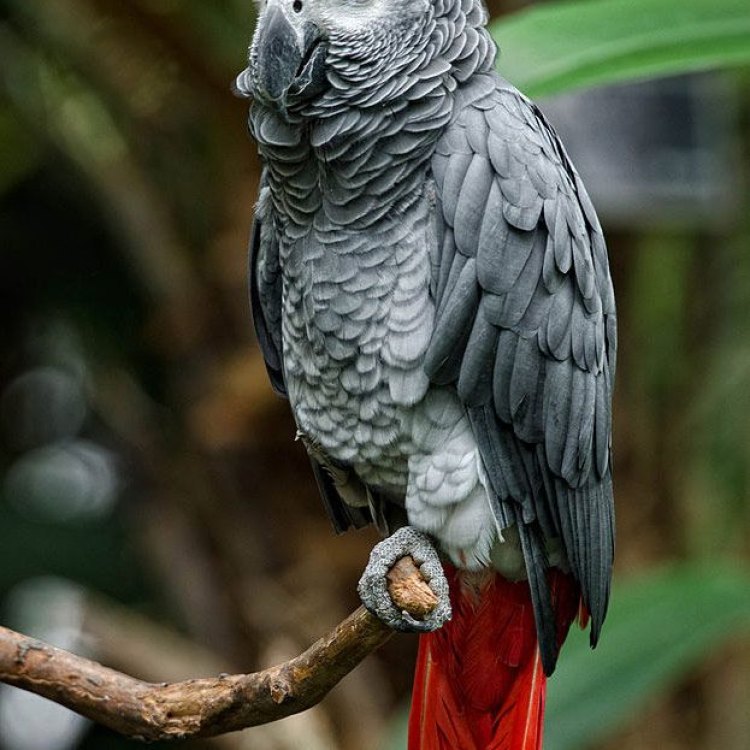
African Grey Parrot
- Adult Size: Medium
- Average Lifespan: 40 - 60 years
- Reproduction: Sexual
- Reproductive Behavior: Monogamous
- Sound or Call: Complex vocalizations including mimicry of human speech and environmental sounds
- Migration Pattern: Non-migratory
- Social Groups: Highly social, forming large flocks
- Behavior: Intelligent and curious
- Threats: Habitat loss, trapping for the pet trade
- Conservation Status: Endangered
- Impact on Ecosystem: Seed dispersal
- Human Use: Popular as pets and in aviculture
- Distinctive Features: Red tail feathers, white mask around the eyes
- Interesting Facts: Considered one of the most intelligent bird species, can learn a large vocabulary and comprehend human speech
- Predator: Large birds of prey
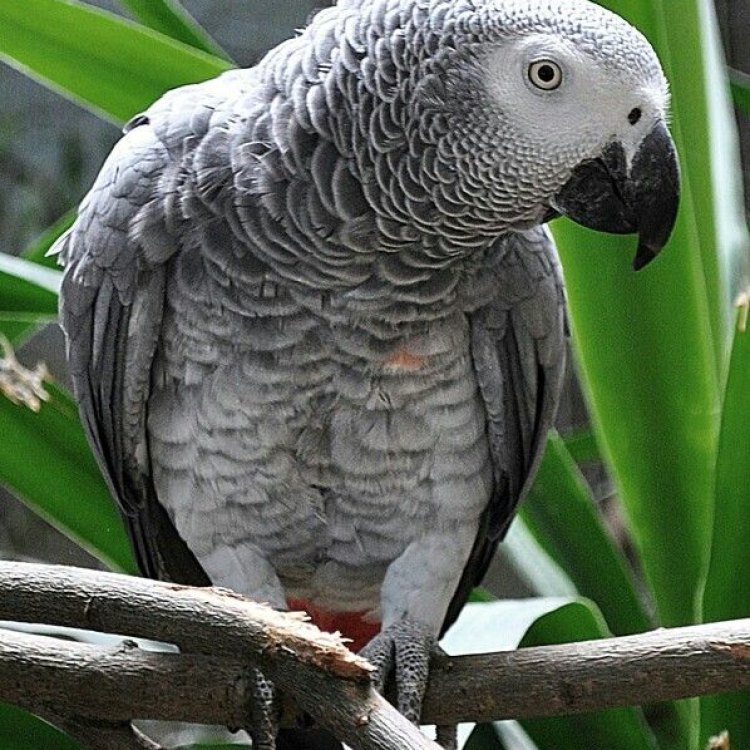
Psittacus erithacus
The Astonishing African Grey Parrot: A True Wonder of Nature
The African Grey Parrot, also known as the Congo Grey Parrot, is a medium-sized parrot species native to central and western Africa. Known for its intelligence, mimicry abilities, and striking appearance, this bird has captured the hearts of many.Adult African Grey Parrots typically measure around 13 inches (33 centimeters) in length and weigh between 14 to 20 ounces (400 to 550 grams). They have a lifespan of 40 to 60 years, making them a long-term commitment for any potential owner PeaceOfAnimals.Com.
But what truly sets this species apart is not just its physical appearance, but its remarkable intelligence and distinctive behaviors.
A Life of Intimacy: Sexual Reproduction and Monogamous Behavior
The African Grey Parrot is a sexually reproductive species, with males and females engaging in courtship rituals before mating. This involves displaying their vibrant feathers and performing vocal and physical displays to attract a mate.Once a bond has been formed, these birds become monogamous, meaning they will mate with the same partner for life. They are known to be affectionate and form strong bonds with their partners, often engaging in mutual preening and feeding.
Their reproductive behavior is also notable for their intelligence. African Grey Parrots have been observed using tools to prepare their nest and even using sticks to scratch themselves.
Vocal Virtuosos: Complex Calls and Mimicry
One of the most remarkable aspects of the African Grey Parrot is their vocal abilities. These birds are known for their complex vocalizations, which include a variety of whistles, squawks, and screeches Australian Retriever.But what truly sets them apart is their mimicry abilities. They have the unique ability to learn and mimic a large vocabulary of human speech and even comprehend what is being said. This has earned them the title of one of the most intelligent bird species in the world.
In the wild, African Grey Parrots use their vocalizations for a variety of purposes, including communicating with their flock, attracting a mate, and warning of potential threats. This adaptability and communication skills are what make them a successful and social species.
A Life of Settledness: Non-Migratory and Social Behavior
Unlike many other bird species, the African Grey Parrot is non-migratory, meaning they do not undertake seasonal migrations. They are found in Central and Western Africa, with their range covering countries such as Congo, Ivory Coast, and Ghana.These birds are highly social and form large flocks, often consisting of up to 20 individuals. They engage in activities such as communal roosting and foraging, which helps them bond and ensure their safety in numbers.
In captivity, they also thrive in a social environment, often forming strong bonds with their owners and other household pets.
Menace or Marvelous Companion? A Look at Threats and Conservation Status
Unfortunately, the African Grey Parrot faces several significant threats in the wild. The primary threat is habitat loss, as deforestation for agricultural purposes is rapidly reducing their natural habitat. This loss of habitat has led to a decline in their population, especially in areas where they were once abundant.Another major threat is trapping for the pet trade. Due to their remarkable intelligence, African Grey Parrots are highly sought after as pets. This demand has led to large-scale trapping and illegal trade, causing a noticeable decline in their numbers.
As a result, the African Grey Parrot is listed as an endangered species on the International Union for Conservation of Nature (IUCN) Red List. Conservation efforts are in place to protect their remaining population, including habitat conservation and anti-poaching measures.
The Impact on Ecosystems: Seed Dispersal by the Grey Parrot
Despite their small size, the African Grey Parrot plays a significant role in their ecosystem. As they forage for food, they consume seeds and fruits from various plants, which then pass through their digestive system. When they excrete these seeds as waste, they play a critical role in seed dispersal, helping with the growth and reproduction of different plant species.Because of this role, the decline in their population can have a ripple effect on the ecosystem, affecting plant diversity and potentially disrupting the balance of the ecosystem.
A Popular Companion: Human Use of African Grey Parrots
The African Grey Parrot has been used by humans for various purposes for many years. In some parts of Africa, they are hunted for their meat, which is considered a delicacy.In recent years, these parrots have also become popular pets and are widely kept in aviculture. Their intelligence and mimicry abilities make them fascinating and entertaining companions. However, their popularity as pets has also contributed to their decline in the wild, as many are taken from their natural habitats and illegally traded.
The Unique Features of the African Grey Parrot
The African Grey Parrot has several distinctive features that make it stand out among other bird species. Their most striking feature is their red tail feathers, which beautifully contrast with their grey plumage. In addition, they have a white mask around their eyes, giving them a serene and thoughtful appearance.These unique physical characteristics, coupled with their intelligence and vocal abilities, make the African Grey Parrot a highly sought-after companion.
Fun Facts About the African Grey Parrot
- The African Grey Parrot is known for its remarkable memory and can remember words and phrases for years.- They have been observed engaging in creative problem-solving, such as using tools and working out puzzles.
- In the wild, they have been documented communicating with other bird species, including alarm calls when predators are nearby.
- African Grey Parrots have been featured in literature and pop culture, with famous owners including Winston Churchill and singer Dolly Parton.
The Ultimate Flying Predator: Natural Threats to African Grey Parrots
Despite their intelligence and social behavior, African Grey Parrots are also at risk from natural predators. Large birds of prey, such as hawks, falcons, and owls, can prey on them while they are foraging or flying. However, their flocking behavior and quick thinking can often help them evade these predators.In Conclusion
In conclusion, the African Grey Parrot is a truly remarkable and awe-inspiring species with a unique set of characteristics. From its intelligence and social behavior to its mimicry abilities and distinctive physical features, this bird has captured the attention and hearts of many.While they are facing significant threats in the wild, it's crucial to understand and appreciate the value of these birds to their ecosystem and take steps to protect them. As for their role in the lives of humans, these birds serve as a reminder of the beauty and wonders of nature, and the importance of coexisting and preserving our natural world.
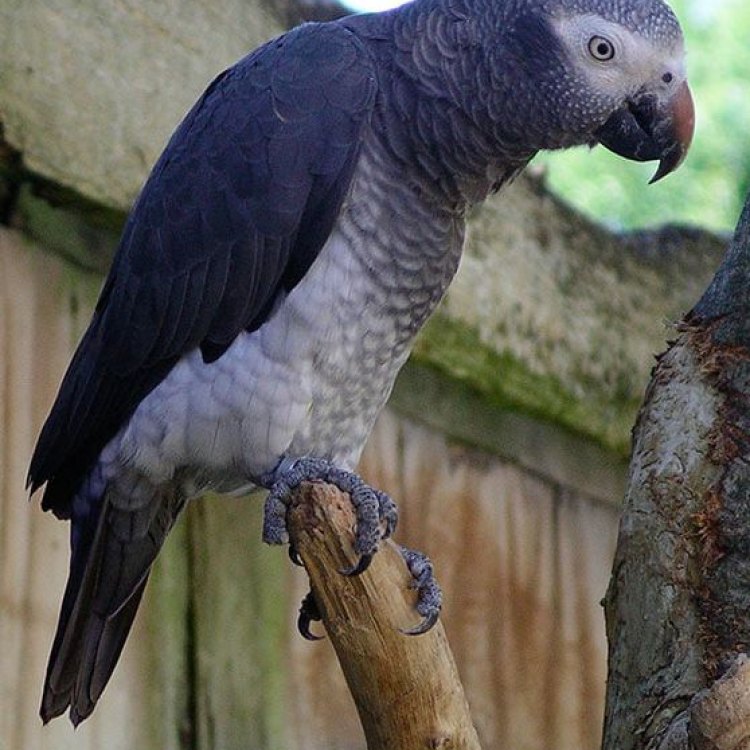
The Fascinating African Grey Parrot: A Unique Species of West and Central Africa
Disclaimer: The content provided is for informational purposes only. We cannot guarantee the accuracy of the information on this page 100%. All information provided here may change without prior notice.

